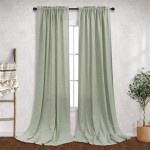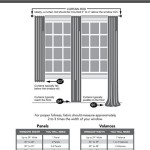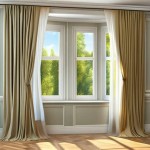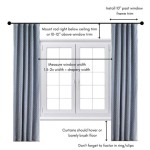How To Hang Outdoor Curtains Without Drilling Holes
Outdoor curtains add a touch of elegance, privacy, and shade to patios, decks, and porches. However, drilling holes to install curtain rods can be a daunting prospect, especially for renters or those who prefer to avoid unnecessary alterations to their outdoor spaces. Fortunately, several methods exist for hanging outdoor curtains without resorting to drilling. These methods prioritize ease of installation and minimal impact on the existing structure, while still providing a functional and aesthetically pleasing result.
Choosing the right method depends largely on the specific structure to which the curtains will be attached. Factors such as the presence of existing posts, beams, or overhangs, as well as the desired curtain style and weight, will influence the selection process. This article explores various techniques for hanging outdoor curtains without drilling, offering practical solutions for a variety of outdoor settings.
Utilizing Tension Rods
Tension rods offer a simple and versatile solution for hanging outdoor curtains without drilling. These rods rely on internal springs to create pressure against two opposing surfaces, providing a secure hold without the need for screws or nails. They are particularly well-suited for spaces with existing structures like pergolas, arbors, or covered porches with solid support beams.
To install tension rods, first ensure that the surfaces on which the rod will rest are clean and dry. This will maximize the friction and prevent slippage. Measure the distance between the two surfaces and select a tension rod that is slightly longer than this measurement. Extend the rod to the appropriate length, compressing the internal spring. Carefully position the rod between the two surfaces and release the tension, allowing the spring to exert pressure and secure the rod in place.
When selecting tension rods for outdoor use, it is crucial to choose models specifically designed for exterior applications. These rods are typically constructed from rust-resistant materials like stainless steel or powder-coated aluminum, ensuring durability and longevity in harsh weather conditions. The weight capacity of the rod should also be considered, taking into account the weight and fabric of the chosen curtains. Heavier curtains may require heavier-duty tension rods to prevent sagging or collapse.
While tension rods offer a convenient solution, they may not be suitable for all situations. They require a relatively narrow and consistent gap between two solid surfaces. Wide spans or uneven surfaces may compromise the rod's stability. Furthermore, strong winds can sometimes dislodge tension rods, particularly if the curtains are heavy or create significant wind resistance. Therefore, it is recommended to use tension rods in sheltered areas or with lighter-weight curtains.
Employing Clip-On Curtain Rings
Clip-on curtain rings provide an alternative method for hanging outdoor curtains without drilling, particularly when an existing structure like a wire, cable, or rope is already in place. These rings feature small clips that attach directly to the fabric of the curtain, allowing it to be suspended from the existing support. This method is ideal for creating a relaxed and informal aesthetic, often seen in bohemian or rustic outdoor settings.
The installation process for clip-on curtain rings is straightforward. Simply attach the clips to the top edge of the curtain panel, spacing them evenly to ensure a uniform drape. The number of clips required will depend on the width of the curtain and the desired fullness. Once the clips are attached, the curtain can be easily hung by sliding the rings onto the existing wire, cable, or rope.
Selecting the right type of clip-on curtain rings is essential for successful outdoor use. Choose rings made from durable, rust-resistant materials like stainless steel or plastic. Consider the size and style of the rings to complement the overall aesthetic of the outdoor space. Rings with a tight grip are crucial to prevent the curtains from slipping or falling, especially in windy conditions.
One advantage of using clip-on curtain rings is their versatility. They can be used with a variety of curtain styles and fabrics, allowing for a wide range of design options. They are also easily adjustable, allowing for quick and easy changes to the curtain height or position. However, clip-on rings may not be suitable for very heavy curtains, as the clips can sometimes damage the fabric or pull away under excessive weight. Regular inspection of the clips is recommended to ensure they remain securely attached to the curtain.
Utilizing Adhesive Hooks and Rods
Adhesive hooks and rods represent another no-drill option for hanging outdoor curtains, offering a relatively simple and affordable solution for various outdoor surfaces. These products rely on strong adhesives to attach to walls, posts, or other structures, providing a stable base for supporting curtains. They are particularly well-suited for smooth, non-porous surfaces like painted wood, metal, or glass.
Before installing adhesive hooks or rods, it is crucial to thoroughly clean the surface to which they will be attached. Remove any dirt, dust, or grease using a mild detergent and water. Allow the surface to dry completely before proceeding. Follow the manufacturer's instructions carefully when applying the adhesive, ensuring that it is evenly distributed and making firm contact with the surface. Allow the adhesive to cure for the recommended time before hanging the curtains.
Choosing the appropriate adhesive hooks or rods is essential for successful outdoor use. Select products specifically designed for exterior applications, as these typically feature stronger adhesives and weather-resistant materials. Consider the weight capacity of the hooks or rods, taking into account the weight of the curtains. Opt for heavier-duty models for heavier curtains or areas prone to strong winds. It is also important to choose hooks or rods that are compatible with the chosen curtain rod or hanging system.
While adhesive hooks and rods offer a convenient no-drill solution, they have certain limitations. Their effectiveness depends heavily on the quality of the adhesive and the condition of the surface to which they are attached. Porous surfaces or surfaces with peeling paint may not provide a strong enough bond for the adhesive to hold. Furthermore, extreme temperatures or humidity can sometimes weaken the adhesive, causing the hooks or rods to fail. Regular inspection of the adhesive bond is recommended, and reapplication may be necessary over time. It is also important to note that removing adhesive hooks or rods can sometimes damage the underlying surface, potentially requiring repairs.
Creating a Frame with Clamps and Poles
For more robust and adaptable solution, consider constructing a temporary frame using clamps and poles. This method allows for greater flexibility in curtain placement and support, particularly in areas where existing structures are not suitable for other no-drill techniques. It is suitable for decks, patios, and other open spaces where a freestanding curtain setup is desired.
The basic concept involves using sturdy poles, such as those made of metal or treated wood, to create a vertical support structure. These poles are then secured to the existing surface using clamps, such as pipe clamps or C-clamps. The clamps provide a strong and stable connection without the need for drilling. A horizontal pole is then attached to the vertical supports to serve as the curtain rod.
The selection of clamps and poles depends on the desired height and width of the curtain setup, as well as the weight of the curtains. Choose clamps that are appropriately sized for the poles and the supporting surface. Ensure that the clamps are made from rust-resistant materials to withstand outdoor conditions. The poles should be strong enough to support the weight of the curtains without bending or sagging. Consider using adjustable poles to accommodate varying curtain lengths or height preferences.
The installation process involves positioning the vertical poles in the desired location and securing them to the existing surface using the clamps. Ensure that the clamps are tightened securely to prevent movement or slippage. Attach the horizontal pole to the vertical supports using additional clamps or brackets. Hang the curtains from the horizontal pole using curtain rings or other suitable hardware.
This method offers several advantages. It provides a stable and customizable curtain support system that can be adapted to various outdoor settings. The use of clamps allows for easy adjustments or relocation of the curtains as needed. The frame can be disassembled and stored during the off-season. However, this method may be more visually intrusive than other no-drill options, and it requires more planning and assembly. Careful consideration should be given to the aesthetics of the frame and its impact on the overall outdoor space.
Considering Magnetic Curtain Rods
Magnetic curtain rods present a unique solution for hanging outdoor curtains without drilling, specifically designed for metal surfaces. These rods feature strong magnets that adhere directly to steel or other ferromagnetic materials, providing a secure hold without the need for screws, nails, or adhesives. They are particularly well-suited for metal fences, metal sheds, or metal siding.
Before using magnetic curtain rods, it is crucial to ensure that the surface to which they will be attached is indeed magnetic. Test the surface with a small magnet to confirm its compatibility. Clean the surface thoroughly to remove any dirt, rust, or debris that could interfere with the magnetic bond. Position the magnetic curtain rod in the desired location and allow the magnets to adhere to the surface.
When selecting magnetic curtain rods, consider the strength of the magnets and the weight capacity of the rod. Choose rods with magnets that are strong enough to support the weight of the curtains, even in windy conditions. Opt for rods made from rust-resistant materials to prevent corrosion and ensure longevity. The length of the rod should also be appropriate for the width of the curtains.
One advantage of using magnetic curtain rods is their ease of installation and removal. They can be easily repositioned or relocated as needed. They do not leave any permanent marks or holes on the surface. However, magnetic curtain rods are limited to use on magnetic surfaces only. They are not suitable for wood, concrete, or other non-magnetic materials. Furthermore, the strength of the magnetic bond can be affected by the presence of rust, paint, or other coatings on the metal surface. Regular inspection of the magnets is recommended to ensure they remain securely attached to the surface.

Hanging Indoor Curtains Outside Without Drilling Holes

Hanging Indoor Curtains Outside Without Drilling Holes

Hanging Indoor Curtains Outside Without Drilling Holes

Hanging Indoor Curtains Outside Without Drilling Holes

How To Hang Outdoor Curtains With Ease

Hanging Indoor Curtains Outside Without Drilling Holes Outdoor Curtain Rods For Patio

How To Hang Outdoor Curtains The Cover Blog

How To Hang Curtains Without Making Holes In The Wall Interior Design Wonderhowto

Tips For Hanging Outdoor Curtains Without Drilling Support Stepdads

4 Easy Ways To Hang Curtains Without Drilling








